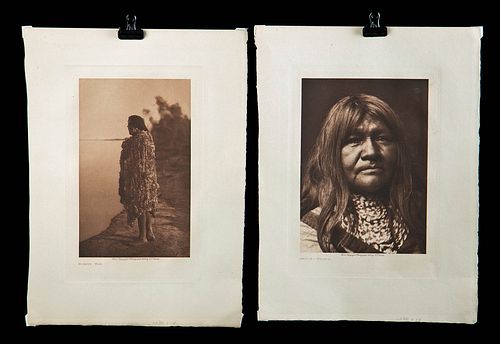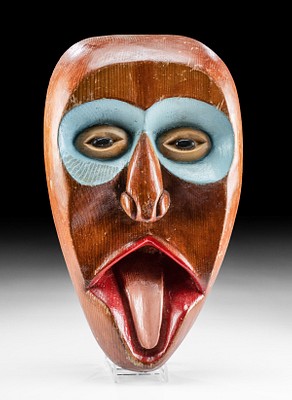Two 1907 Edward Curtis Photogravures
Lot 230
About Seller
Artemis Gallery
686 S Taylor Ave, Ste 106
Louisville, CO 80027
United States
Selling antiquities, ancient and ethnographic art online since 1993, Artemis Gallery specializes in Classical Antiquities (Egyptian, Greek, Roman, Near Eastern), Asian, Pre-Columbian, African / Tribal / Oceanographic art. Our extensive inventory includes pottery, stone, metal, wood, glass and textil...Read more
Categories
Estimate:
$600 - $900
Absentee vs Live bid
Two ways to bid:
- Leave a max absentee bid and the platform will bid on your behalf up to your maximum bid during the live auction.
- Bid live during the auction and your bids will be submitted real-time to the auctioneer.
Bid Increments
| Price | Bid Increment |
|---|---|
| $0 | $25 |
| $300 | $50 |
| $1,000 | $100 |
| $2,000 | $250 |
| $5,000 | $500 |
| $10,000 | $1,000 |
| $20,000 | $2,500 |
| $50,000 | $5,000 |
| $100,000 | $10,000 |
| $200,000 | $20,000 |
About Auction
By Artemis Gallery
Sep 9, 2021
Set Reminder
2021-09-09 10:00:00
2021-09-09 10:00:00
America/New_York
Bidsquare
Bidsquare : Art & Artifacts of North America
https://www.bidsquare.com/auctions/artemis-gallery/art-artifacts-of-north-america-7436
Join us for a special auction not to be missed! Collectible Native American art from antiquity to mid-20th century, Spanish Colonial, Latin American, fine & folk art, American frontier items, and much more! Artemis Gallery info@artemisgallery.com
Join us for a special auction not to be missed! Collectible Native American art from antiquity to mid-20th century, Spanish Colonial, Latin American, fine & folk art, American frontier items, and much more! Artemis Gallery info@artemisgallery.com
- Lot Description
Edward Sheriff Curtis (American, 1868-1952). "Mohave Man" (1907) and "Nerije Walapai" (1907) - two photogravures, 1907. A captivating pair of photogravures demonstrating American photographer Edward Curtis' artistry as well as his ethnographic intent. "Nerije - Walapai" presents a bust-length portrait of the sitter who faces the viewer, wears an elaborate beaded necklace, and presents an expressive visage framed by long hair that falls below his shoulders. "Mohave Man" is dressed in a long fur garment and stands in contemplation before an expansive body of water. Both portraits were part of Edward Curtis' epic 20 volume project to document Native Americans threatened by Westward expansion in the United States entitled "The North American Indian" (1907-1930) - a project that experts have estimated would cost more than $35 million to create today. Size of image (Nerije-Walapai): 7.375" L x 5.375" W (18.7 cm x 13.7 cm) Size of sheet: 12.375" L x 9.25" W (31.4 cm x 23.5 cm)
To learn more about Curtis' impressive undertaking, please read Gilbert King's article in Smithsonian Magazine. It opens as follows, with King brilliantly capturing Curtis' urgency and steadfast work ethic to document the indigenous peoples before expansion would potentially eclipse their cultures, "Year after year, he packed his camera and supplies—everything he’d need for months—and traveled by foot and by horse deep into the Indian territories. At the beginning of the 20th century, Edward S. Curtis worked in the belief that he was in a desperate race against time to document, with film, sound and scholarship, the North American Indian before white expansion and the federal government destroyed what remained of their natives’ way of life. For thirty years, with the backing of men like J. Pierpont Morgan and former president Theodore Roosevelt, but at great expense to his family life and his health, Curtis lived among dozens of native tribes, devoting his life to his calling until he produced a definitive and unparalleled work, The North American Indian. The New York Herald hailed as 'the most ambitious enterprise in publishing since the production of the King James Bible.'" ("Edward Curtis’ Epic Project to Photograph Native Americans" by Gilbert King - Smithsonian Magazine March 21, 2012)
While Curtis has had his critics who have claimed that he romanticized the natives' existence, others have argued that he was ahead of his time and depicted them with dignity and respect. In her book entitled, "Shadow Catcher: The Life and Work of Edward S. Curtis" (Bison Books, 2005) Laurie Lawlor wrote, "When judged by the standards of his time, Curtis was far ahead of his contemporaries in sensitivity, tolerance and openness to Native American cultures and ways of thinking. He sought to observe and understand by going directly into the field."
Provenance: Jon and Mary Williams private art collection, Denver, Colorado, USA
All items legal to buy/sell under U.S. Statute covering cultural patrimony Code 2600, CHAPTER 14, and are guaranteed to be as described or your money back.
A Certificate of Authenticity will accompany all winning bids.
PLEASE NOTE: Due to recent increases of shipments being seized by Australian & German customs (even for items with pre-UNESCO provenance), we will no longer ship most antiquities and ancient Chinese art to Australia & Germany. For categories of items that are acceptable to ship to Australia or Germany, please contact us directly or work with your local customs brokerage firm.
Display stands not described as included/custom in the item description are for photography purposes only and will not be included with the item upon shipping.
#166576Both show slight toning and age wear, but are in very good condition overall with vivid details. Titles and "From Copyright Photograph 1907 by E.S. Curtis" printed below each image.Condition
- Shipping Info
-
All shipping is handled in-house for your convenience. Your invoice from Artemis Gallery will include shipping calculation instructions. If in doubt, please inquire BEFORE bidding for estimated shipping costs for individual items.
-
- Buyer's Premium



 EUR
EUR CAD
CAD AUD
AUD GBP
GBP MXN
MXN HKD
HKD CNY
CNY MYR
MYR SEK
SEK SGD
SGD CHF
CHF THB
THB














